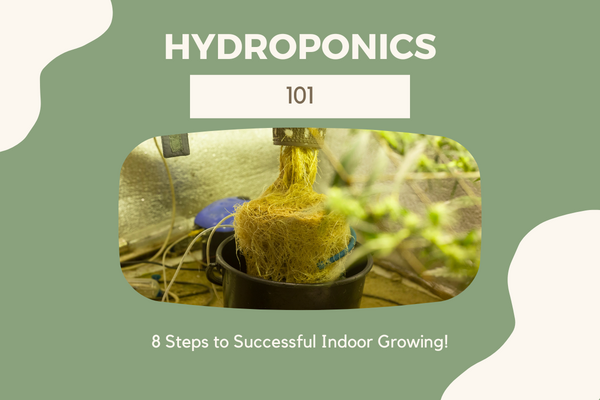
Hydroponics 101 – 8 Steps to successful indoor growing!
Hydroponic crops can use up to 80% less water than soil grown crops, when in a recirculating system. You can plant 4 times the number of hydroponic crops in the same area that soil crops need to grow.
Hydroponic crops can grow twice as fast too. Hydroponically grown crops can be grown organically and without the use of herbicides & pesticides. Here are 8 steps for successful indoor cannabis growing!
hy•dro•pon•ics
noun: the science of growing or the production of plants in nutrient rich solutions of moist inert material, instead of soil.
The Right Environment
• Key components include relative humidity, temperature, CO2, and air circulation/exchange
• Ideal humidity is between 40%-60%
• Some plants like higher humidity, but that can lead to problems with fungus and disease
• Ideal temperature is between 68-75F
• Plants need CO2 to grow - with good air circulation and exchange, a room will naturally have between 300-400 PPM without supplemental CO2
Start With Good Water
• Water quality is essential to plant growth
• PPM (parts per million) or EC (electrical conductivity) measure salts in a solution
• Start off with a low PPM or EC and add nutrients specific to your plant variety requirements
• A Reverse Osmosis system can reduce PPM/EC
• pH (potential hydrogen) measures acidity of alkalinity in a solution on a scale of 0-14
• Nutrient "lockout" occurs in too high or low pH levels
Choose A Method
• Ebb & Flow gardens flood and drain a tray of plants with a nutrient solution at regular intervals
• Drip gardens provide a nutrient solution to each plant through tubes & emitters (drip stakes)
• Aeroponic gardens mist an oxygenated nutrient solution directly to the roots of its plants
• NFT (Nutrient Film Technique gardens flow a slow moving nutrient solution over the plants roots
• Organics are possible using many methods, and are often grown in container gardens
Choose A Media
• Growing mediums act as the root anchor system
• Coco is made from the husks of a coconut, is PH stable, and provides moisture retention/aeration
• Expanded clay pebbles provide moisture retention/aeration and are reusable if sterilized
• Rockwool stone is heated and spun into fibers then compressed, provides an excellent oxygen to water ratio, though flushing/conditioning is recommended
• Silica helps slow transpiration, provides moisture retention/aeration, and is reusable if sterilized
• Peat mixes can be altered to varying air/water ratios
Nutrients/ Fertilizers
• Liquid/Dry nutrients can be organic or synthetic
• Over or under fertilizing can cause burning, curling or yellowing of plants
• Most nutrient bottles are labeled with N-P-K (Nitrogen, Phosphorus, and Potassium)
• Additives/supplements can bolster microbial activity at the root zone, strengthen plant cell walls, increase flower sites, shorten length to harvest, increase size, flavor and aroma of fruits and flowers and more
• When used together, nutrients and supplements will help you achieve maximum results
Grow Lighting
• MH (Metal Halide) and HPS (High Pressure Sodium) are types of HID lights used in grow rooms
• MH lamps = Blue spectrum for vegetative
• HPS lamps = Orange/Red spectrum for flowering
• T5 lamps are high-output fluorescents with low heat/energy consumption ideal for cuttings, mother plants, and short growth cycles
• DE (Double Ended) lighting is a full spectrum HID lamp with a higher par reading than single ended
• Plants in vegetative stage need 15-18 hrs. of light
• Plants in bloom stage need 10-12 hrs. of light
Testing Equipment
• There are many meters available for testing solution pH, PPM, and EC
• Environmental controllers and meters are available to automate and more accurately control and maintain the temperature, humidity, CO2 and lights
• Testing equipment for the water-nutrient solution, light, room temperature and humidity, CO2, and air circulation is the key to providing optimal conditions for a bountiful garden
Optional Accessories
• Grow/Garden room accessories are essential for optimized growth and harvest
• Atmosphere drive devices such as fans, blowers, CO2 emitters, and integrated timers are a grow rooms greatest accessory
• Trellising, stakes, supports, shears, and labels are useful when growing fruiting/flowering crops
• Pest and disease control may be needed and there are many organic options available
No posts found
Write a review
